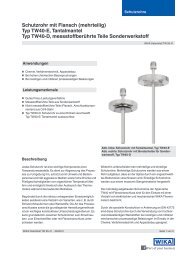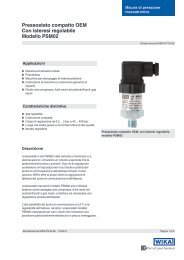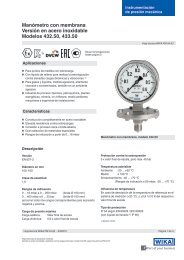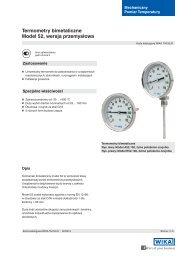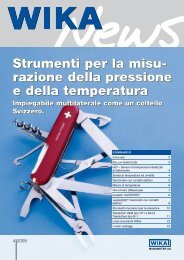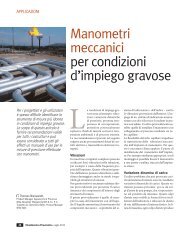2015 WIKA USA
WIKA Price List
WIKA Price List
Create successful ePaper yourself
Turn your PDF publications into a flip-book with our unique Google optimized e-Paper software.
ADVANTAGES OF LIQUID-FILLED GAUGES<br />
MSRP List > Advantages of Liquid-filled Gauges<br />
Advantages of Liquid-filled Gauges<br />
Liquid-filled gauges<br />
Liquid-filled pressure gauges provide a number of advantages:<br />
• the liquid absorbs vibration and pressure spikes<br />
• the dampening action of the liquid enables the operator to<br />
take readings during conditions of rapid dynamic loading and<br />
vibration<br />
• the liquid lubricates all moving elements, dramatically<br />
reducing wear in the movement<br />
• because most liquid-filled gauges are filled with non-aqueous<br />
liquid and hermetically sealed, they perform in corrosive<br />
environments and are immune to moisture penetration and<br />
icing and shock effects are lessened<br />
Liquid-filled gauges enhance the reliability and integrity of the<br />
measuring system for long periods under extreme operating<br />
conditions.<br />
Liquid-fill fluid<br />
Ambient Temperature Ratings (Table A)<br />
Allowable operating range - Temperature range in which the<br />
operation of the gauge is not adversely affected by the filling<br />
liquid. At temperatures above the maximum rating, the fluid<br />
may break down. At temperatures below the minimum rating,<br />
the fluid may solidify (freeze).<br />
Choose the right liquid<br />
The type of liquid used to fill the gauge varies with the application.<br />
Although pure glycerine provides the best performance<br />
in most applications, each has its own requirements.<br />
Guidelines to help ensure that a fluid is properly matched to<br />
an application are:<br />
• if icing is a problem, use gauges filled with silicone oil<br />
or other comparable liquids. They have low viscosities<br />
even at -60 o C<br />
• if the system has electric accessories, such as<br />
contacts, use insulating oils<br />
• if extreme temperature fluctuations are expected,<br />
use silicone oils<br />
The higher the liquid viscosity, the greater its dampening<br />
capacity. The reason for this is that dampening changes in<br />
proportion to the temperature-dependent viscosity of the<br />
filling liquid. The suitable degree of dampening depends<br />
on the operating requirements the gauge must meet, such<br />
as pointer response time, pressure extremes, vibration and<br />
changes in pressure. <strong>WIKA</strong> can recommend specific liquids<br />
to suit problem applications.<br />
Fill Fluid<br />
Allowable Operating Range<br />
!<br />
NOTE: Some parts of the pressure gauge may not be<br />
able to withstand temperatures above 140 o F. Consult<br />
with the factory for technical assistance for these<br />
applications.<br />
Glycerine<br />
Dow 99.7% USP, Synthetic<br />
1118 Centistokes at 68°F<br />
Silicone<br />
Dow Corning 200 Fluid<br />
1000 Centistokes at 77°F<br />
Halocarbon®<br />
Halocarbon® Products<br />
6.3 Centistokes at 100°F<br />
-4°F to 140°F -20°C to 60°C<br />
-40°F to 140°F -40°C to 60°C<br />
-40°F to 140°F -40°C to 60°C<br />
Table A - Allowable Ambient Temperature Ratings<br />
Liquid-filled gauge case venting<br />
For pressure gauges with full scale ranges of 300 psi and below (including vacuum and compound ranges of 30 inHg-0-200 psi<br />
and below), case venting (after the gauge is installed) is necessary to preserve the accuracy. Temperature fluctuations during<br />
shipment and in the process application cause the liquid filling to expand and contract which in turn increases or decreases case<br />
pressure. As a result, accuracy can be decreased and the pointer may not return to zero properly until the gauge is vented to the<br />
atmosphere.<br />
To vent a <strong>WIKA</strong> gauge, move the valve to the open position which will release any pressure or vacuum built up in the case. If<br />
the gauge is installed in an upright position, the lever can be left in the open position. The lever allows the use of a gauge in a<br />
non-upright orientation.<br />
5





